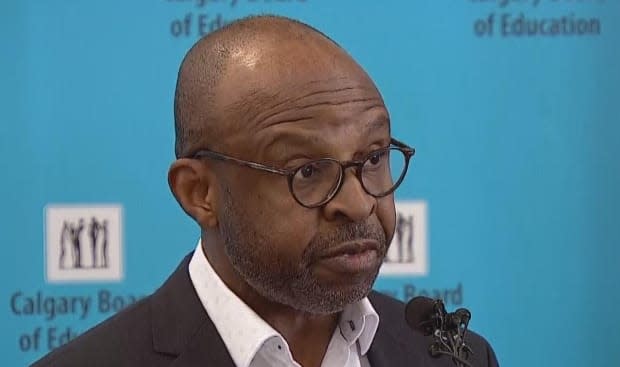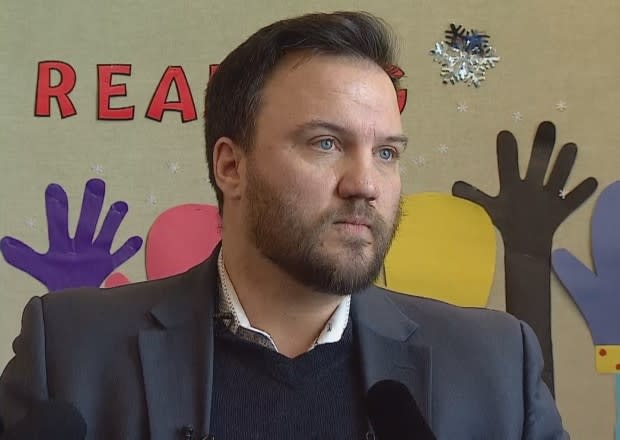Teacher says conditions 'dangerous' at Calgary high school that had COVID-19 outbreak
A Calgary teacher working at a public high school where a COVID-19 outbreak has been declared says he doesn't feel safe at work because of the sheer number of people he comes in contact with each day.
CBC News has agreed not to name the teacher because he fears professional retribution.
"I can tell you that from my perspective as a teacher, I feel that I have the most dangerous job as a teacher in the province," said the Lester B. Pearson High School teacher.
Earlier this week the AHS declared a COVID-19 outbreak at the school after two cases were identified leading to the quarantine of dozens of students and teachers.
The teacher says he feels K to 9 schools are much safer than high schools because they're controlling the movement of students and staff more closely.
"If I was teaching kindergarten I'd be worried, but I'd know that at least I'm only dealing with that one cohort group of kids," he said.
But at Calgary Board of Education high schools, that's not the case.

"In the first period class that a kid might have 35 kids in there, and then leave the class and they go to period number two with an entirely different group of 35 kids. They then go for lunch, which is structured as it can be, but it's absolute chaos," he said.
"Then they will go to period three with an entirely different group of 35 kids, and then they'll go to period four with yet another entirely different group of 35 kids."
Jonathan Teghtmeyer, associate coordinator of communications for the Alberta Teacher's Association, said the union is hearing from teachers across the province about this issue.
"Teachers are concerned that cohorts are being broken. So this this comes from students convening outside of their cohort during lunch time, before or after school, on buses, stuff like that," he said. "So there is a sense that the cohorting system may not be working as well as it should be."
In an emailed statement to CBC News, the Calgary Board of Education said it encourages and expects two-way communication between staff and their supervisor.

"If they have concerns about issues, related to COVID-19 or other issues, they should raise them first with their supervisor who will try and address them. If the supervisor is unable to address the concern they can then raise it with their supervisor," said chief superintendent Christopher Usih.
"In this case the teacher should raise their concerns with the principal, and if necessary, the principal can discuss it with their education director."
Usih said that it has been providing leaders in the CBE, including principals, with extensive communications related to managing COVID related issues both in writing and through online meetings.
"As new issues arise, that communication is updated. As this is an ever evolving situation, answers may not always be immediately available," he said. "In that circumstance we would ask the teacher to raise the issue and then it can be reviewed and addressed."
But, the teacher from Pearson said he feels no one is taking any responsibility.
'Passing the buck'
"It seems to me that everyone is passing the buck. The Alberta government passing the buck to the CBE, and then the CBE, when I bring it up with my hierarchy, says, 'Well, the government of Alberta said back to school, same as it was before, make it work. We don't have the power to do anything different because we are told scenario one,'" he said.
"And so I then asked my professional association, 'How come me as a teacher, my working conditions are so much different than my other colleagues?' And of course, they say, 'Well look, high school is different.' OK, but why should I be putting myself at risk? And why should the students be putting themselves at risk when it's safer from K to 9?"
The teacher says he feels there are better examples, in other parts of the province, of how to limit cohorts.
"Edmonton public, they've broken it down so kids would only have two movements in a day. So there would only be two groups of kids that could be contaminated to through a positive test," he said.
The day after an outbreak was announced at Pearson, the teacher said he noticed the impacts immediately.
"In my first class I have about five to six in that class that are isolated at home because they had been in contact. My next class, I had one third missing and my final class, I had half missing," he said.
And now, the teacher said he's expected to deliver lessons to students in class — as well as to students who are under quarantine at home.
"I appreciate the opportunity to have that available to me and I'm a teacher, so I like to teach, but the complexity of it is pretty amazing," he said.
Teghtmeyer said this is another concern teachers have raised with the ATA.

"The burden of having to teach some students online and some students in person and having to switch rapidly from one to another, the challenges associated with that are really quite significant," he said.
"What you do to teach students in front of you is very different from what you do to support their learning at home. And you almost have to prepare for those completely separately. So that's essentially doubling a lot of the out of school work that a teacher would do."
The teacher said he's not raising these concerns because he wants out of doing his job, but because he doesn't feel like people truly know what it's like inside high schools right now.
"I see neither consistency nor transparency with what's happening right now. And I can't see how kids or teachers can be feeling comfortable in this scenario," he said.
"My honest belief is me, as a high school teacher in northeast Calgary, I am cannon fodder. I'm being thrown to the wolves," he said. "My colleagues in Edmonton public, Calgary Catholic and all my colleagues from K to 9 have a much safer working environment than I do."
Teghtmeyer said ultimately a lot of these challenges are addressed by staffing.
"By hiring some more teachers, hiring some more substitute teachers and getting teachers, getting more teachers into the online environment, getting more teachers into the school environment," he said.
"And those can be deployed in a lot of ways, whether it's reducing class sizes or whether it's just providing additional support for students that have to transition to at-home learning."
The CBE said they have done just that, with the recent hire of nearly 150 new teachers to support the new Hub online learning system.

